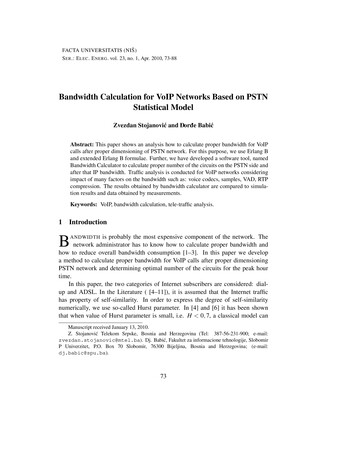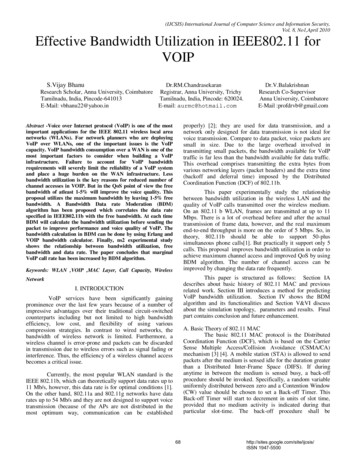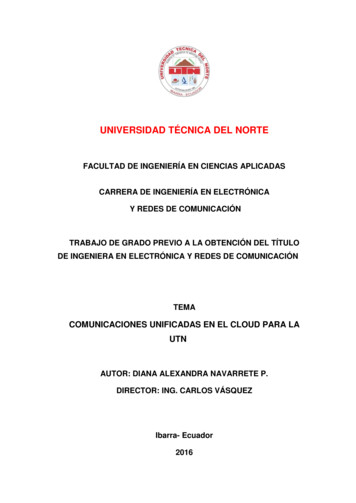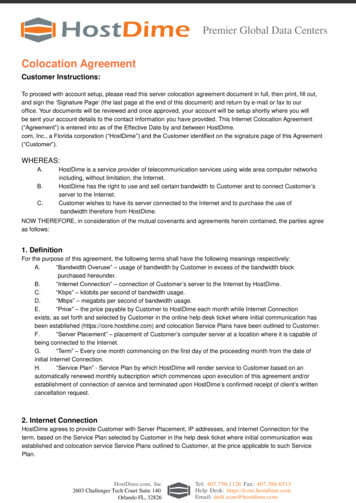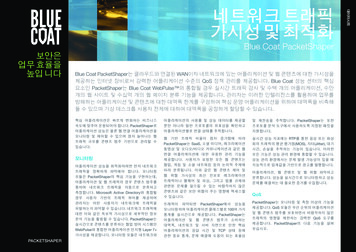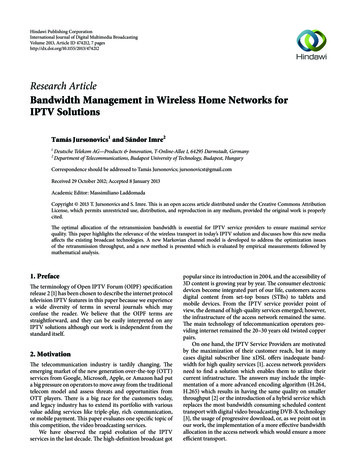
Transcription
Hindawi Publishing CorporationInternational Journal of Digital Multimedia BroadcastingVolume 2013, Article ID 474212, 7 pageshttp://dx.doi.org/10.1155/2013/474212Research ArticleBandwidth Management in Wireless Home Networks forIPTV SolutionsTamás Jursonovics1 and Sándor Imre212Deutsche Telekom AG—Products & Innovation, T-Online-Allee 1, 64295 Darmstadt, GermanyDepartment of Telecommunications, Budapest University of Technology, Budapest, HungaryCorrespondence should be addressed to Tamás Jursonovics; jursonovicst@gmail.comReceived 29 October 2012; Accepted 8 January 2013Academic Editor: Massimiliano LaddomadaCopyright 2013 T. Jursonovics and S. Imre. This is an open access article distributed under the Creative Commons AttributionLicense, which permits unrestricted use, distribution, and reproduction in any medium, provided the original work is properlycited.The optimal allocation of the retransmission bandwidth is essential for IPTV service providers to ensure maximal servicequality. This paper highlights the relevance of the wireless transport in today’s IPTV solution and discusses how this new mediaaffects the existing broadcast technologies. A new Markovian channel model is developed to address the optimization issuesof the retransmission throughput, and a new method is presented which is evaluated by empirical measurements followed bymathematical analysis.1. PrefaceThe terminology of Open IPTV Forum (OIPF) specificationrelease 2 [1] has been chosen to describe the internet protocoltelevision IPTV features in this paper because we experiencea wide diversity of terms in several journals which mayconfuse the reader. We believe that the OIPF terms arestraightforward, and they can be easily interpreted on anyIPTV solutions although our work is independent from thestandard itself.2. MotivationThe telecommunication industry is tardily changing. Theemerging market of the new generation over-the-top (OTT)services from Google, Microsoft, Apple, or Amazon had puta big pressure on operators to move away from the traditionaltelecom model and assess threats and opportunities fromOTT players. There is a big race for the customers today,and legacy industry has to extend its portfolio with variousvalue adding services like triple-play, rich communication,or mobile payment. This paper evaluates one specific topic ofthis competition, the video broadcasting services.We have observed the rapid evolution of the IPTVservices in the last decade. The high-definition broadcast gotpopular since its introduction in 2004, and the accessibility of3D content is growing year by year. The consumer electronicdevices become integrated part of our life, customers accessdigital content from set-top boxes (STBs) to tablets andmobile devices. From the IPTV service provider point ofview, the demand of high-quality services emerged; however,the infrastructure of the access network remained the same.The main technology of telecommunication operators providing internet remained the 20–30 years old twisted copperpairs.On one hand, the IPTV Service Providers are motivatedby the maximization of their customer reach, but in manycases digital subscriber line xDSL offers inadequate bandwidth for high quality services [1]. access network providersneed to find a solution which enables them to utilize theircurrent infrastructure. The answers may include the implementation of a more advanced encoding algorithm (H.264,H.265) which results in having the same quality on smallerthroughput [2] or the introduction of a hybrid service whichreplaces the most bandwidth consuming scheduled contenttransport with digital video broadcasting DVB-X technology[3], the usage of progressive download, or, as we point out inour work, the implementation of a more effective bandwidthallocation in the access network which would ensure a moreefficient transport.
2International Journal of Digital Multimedia BroadcastingBandwidthThroughputOpportunity-aPrio 3InternetPrio 2IPTVSDHD streamSDRETAV dataOpportunity-b𝐵stream𝐵AV data𝐵critSD streamPrio 1-voiceFigure 1: Bandwidth allocation in the access network.𝑃overload 𝑃crit,stat𝑃crit,dyn𝑃LOSSDynamic BW allocationStatic BW allocationFigure 2: Static versus dynamic bandwidth allocation.On the other hand, the service portability allows consumers to access the content not only on STBs, but also fromvarious hand-held devices. Today the prime wireless accesstechnology within the consumer domain is the wireless localarea network WLAN connection, therefore service platformproviders have to adapt their IPTV solution to supportthe specific requirements of this wireless communicationchannel.Most of the current research papers [4–6] take onlyone of the above mentioned two aspects into consideration.The effect of the wireless channel is usually addressed onthe media access control layer, and the research of theIPTV distribution focuses only on the quality of the fixednetwork infrastructure. Our research does address the abovedescribed overlap of the IPTV delivery over WLAN in a limited resource environment of xDSL technology. We presentthe concept and main problems of bandwidth allocationin Section 3. Our new theoretical model is introduced bySection 4. We develop a more effective bandwidth allocationalgorithm in Section 5, which we evaluate and validate.Finally, Section 6 concludes our work and shows somepotential further application areas.3. Bandwidth AllocationLet us begin the discussion of bandwidth managementby introducing a typical triple-play bandwidth allocationscheme on Figure 1. Access network providers usually dedicate a reserved bandwidth in the access network forvoice communication and share the remaining throughputbetween IPTV and internet services with a priority for theformer one.The actual throughput of IPTV service depends on theuser’s configuration. In most of the cases, a token-basedstream management allows the customers to simultaneouslyreceive multiple streams for live viewing or recording purposes (1SD 1HD or 3SD 0HD).One token allocates bandwidth for the AV (audio-video)data transport and reserves a dedicated bandwidth for theretransmission RET service. We discuss the problem andtradeoff of this bandwidth allocation, therefore, in the following paragraphs, we are going to describe it in details.The balance between the assigned bandwidth for AV dataand the reserved bandwidth for RET service is crucial forachieving the maximal quality in IPTV solutions. On onehand the stream bandwidth as constant in time (because ofthe widely applied is considered constant bitrate CBR videoencoding) the more throughput is assigned for the AV dataand the better stream quality can be achieved by the increaseof the encoding bitrate but the less opportunity is given forerror correction. A smooth sharp stream may be disturbedby blocking or full frame outages due to the insufficient RETthroughput. On the other hands reserving high bandwidthfor error correction degrades the overall stream quality dueto the low encoding bitrate. Based on different networkinstallations, the ratio of RET bandwidth to AV data is usuallytuned between 10 and 25%, but a suboptimal value maysignificantly reduce the throughput and, quality of an IPTVSolution.4. Proposed Model for Bandwidth AllocationIPTV Solutions in WLAN Home NetworksThe main concept and benefits of our research are showed byFigure 2. The solid line represents the theoretical throughputof the AV data stream at various packet loss probabilities incase of static bandwidth allocation. The function is constanttill 𝑃overload loss probability, where the loss rate is so highthat the retransmission traffic fully occupies its reservedbandwidth. Above this, rate retransmission does not haveenough bandwidth to recover all the packet losses; therefore,the actual throughput of AV data stream is decreasing(not transmitted packets), and customers experience qualitydeterioration. We also declare a critical bandwidth value(𝐵crit ) for AV data transmission. [Below this value, it does notmake sense to provide IPTV service due to the massive losses.A dynamic bandwidth allocation (dash-dot line onFigure 2) increases the throughput of the AV stream atlow packet loss rates to achieve a better quality for theIPTV service (opportunity-a). Secondly, at higher loss rates,the throughput of AV stream decreased to avoid doublepacket delivery (opportunity-b) which enables the operatorto expand the value of the critical packet loss rate (𝑃crit,dyn )and provides a lower quality but error-free IPTV service in aworst environment.In this paper we present only one part of our overall research, the optimal selection of the retransmissionthroughput. Our method—introduced by the upcomingsections—predicts the loss attributes of the wireless transmission and defines the optimal value of the RET throughputconsidering the overall loss parameters with the aim of
International Journal of Digital Multimedia Broadcasting𝑍𝑛3Let us observe that the first term of the addition equalsto 0 by definition and the last term equals to the samplingof the 𝑍𝑛 white noise with its own delayed signal. Theautocorrelation of the white noise is zero for all nonzero timeshifts [7]; therefore, 𝑅𝑛 can be described as a sequence ofan independent random variable which satisfies the MarkovChannel 1𝐵 𝐵𝑛𝑑𝐶𝑛def𝑆𝑛TX𝑆𝑛 𝑑𝑅𝑛RX𝑑 𝑍𝑛𝑅𝑛 Figure 3: Channel model.minimizing packet losses. First, we describe the channel andthe bandwidth models.property. 𝑋𝑛 𝑅𝑛 is a homogeneous Markov chain.Let 𝑋𝑛 0 if the 𝑛th packet is received correctly; 𝑋𝑛 1 ifthe 𝑛th packet is lost and has not been retransmitted; finally𝑋𝑛 2 if the 𝑛th packet is successfully retransmitted afterloss. We analyzed and described a three-state Markov modelin our previous publication; therefore, we simply list mostimportant properties. For a detailed discussion including theresolution of (3)–(6) and for the meaning of the probabilities,please refer to our former paper [8].The transition matrix𝑝01𝑝021 𝑝01 𝑝02].𝑝101 𝑝10 𝑝12𝑝12𝑝𝑝1 𝑝 𝑝20212021 ][[4.1. The Channel Model. Considering the requirements aboveand the attributes of a WLAN transport, we decided to introduce a discrete-time channel and a Markov model for themathematical description of the UNIT-17 interface (AV datastreams in the Access and residential Networks). We considernot only the packet arrival, but also the retransmission trafficas a discrete-time stochastic process, and we prove that it is ahomogeneous Markov chain.Let 𝑆𝑛 {0, for all 𝑛} represent the number of sentpackets at the time 𝑛 on Figure 3, TX the multicast contentdelivery function, 𝑍𝑛 {0; 1, for all 𝑛} an additive white noisein the wireless communication channel, d the transmissiondelay, and RX the open IPTV terminal function (OITF). Thereceived packets are expressed with 𝑅𝑛 {0, for successfulpacket transmission; 1, for packet loss}. We assume that thereceiver detects a packet loss (by checking the sequencenumbers of packets) and requests the retransmission 𝐵𝑛 {1,for a packet retransmission; 0 otherwise} of every lost packetsonly once from the B Fast Channel Change/Retransmissionserver. We also assume that the retransmission requestcommunication is protected by an error-free protocol, likeTCP. By this definition, we obtainAnd the probability of loss burst with length 𝑙𝐵𝑛 𝑅𝑛 𝑍𝑛 𝑑 .𝑃RET,burst (𝑙) (1 𝑝20 𝑝21 )(1)The 𝐵𝑛 signal travels through the same wireless channel;therefore, it is also effected by the same 𝑍𝑛 noise, and it maybe also lost. We model this effect by expressing the receivedcorrection signal 𝐶𝑛 {0, 1} with three operators, an inverter( 1), a multiplier ( ), and a channel transmission delay (d).These functions enable us to assign the value of 1 for 𝐶𝑛 onlyin the case when the retransmission signal is not effected bythe channel noise (not lost), and the value of 0 otherwise.The final received and corrected signal 𝑅𝑛 {0, for successful packet transmission, 1 for packet loss (unsuccessfulretransmission), and 2 for successful packet retransmission}is 1𝑅𝑛 𝑅𝑛 𝑑 𝐶𝑛 𝑆𝑛 2𝑑 𝑍𝑛 2𝑑 𝐵𝑛 𝑑 𝑍𝑛 𝑑 1 𝑆𝑛 2𝑑 𝑍𝑛 2𝑑 𝑍𝑛 2𝑑 𝑍𝑛 𝑑.(2)(3)The steady-state packet loss rate𝑃LOSS,steady (𝑝02 𝑝21 𝑝01 𝑝20 𝑝01 𝑝21 ) (𝑝01 𝑝20 𝑝01 𝑝21 𝑝02 𝑝21 𝑝10 𝑝02 𝑝12 𝑝01 1 𝑝12 𝑝02 𝑝21 𝑝10 𝑝20 𝑝10 𝑝20 𝑝12 ) .(4)The steady-state packet retransmission rate𝑃RET,steady (𝑝10 𝑝02 𝑝12 𝑝01 𝑝12 𝑝02 ) (𝑝01 𝑝20 𝑝01 𝑝21 𝑝02 𝑝21 𝑝10 𝑝02 𝑝12 𝑝01 1 𝑝12 𝑝02 𝑝21 𝑝10 𝑝20 𝑝10 𝑝20 𝑝12 ) .(5)𝑙 1(𝑝20 𝑝21 ) .(6)4.2. The Model of Bandwidth Limitation. The previous sectionintroduced how the wireless channel affects the packet transmission, and now we are going to analyze the the bandwidthallocation in IPTV solutions.We introduce three planes of the IPTV packet transmission. The transmitter plane represents the provider’snetwork, receiver plane represents the OITF, and playout planrepresents the content presentation within the OITF. Theevents of the packet loss usually show a burstiness in wirelesscommunication [9–11]. Therefore, we investigate an intraburst loss on Figure 4 after the first 𝑘 consecutive packetlosses (b) the receiver requests them for retransmission (c)which packets are delivered within the allocated bandwidthfor packet transmission (d) to the presentation device (e). Fora successful retransmission, all retransmitted packet should
4International Journal of Digital Multimedia BroadcastingBandwidthBandwidth(c) Retransmitted(c) RetransmittedRETAVdata···112··· 𝑘𝑘1· · · 𝑘 · · ·······(a) Sent ···𝑛· · · (a) Sent packetsTransmitter𝑡(d) Ret. received(d) Ret. receivedRET···1RETAVdata𝑘RETAVdata1 2 · · · 𝑘 (b) Lost packetsReceiver···1 · · · 𝑘· · ver𝑡𝑡(e) Played out(b) Lost packetsAVdata12··· 𝑘𝐷ret𝐷playo𝑇retAVdata(e) Played outPlayout𝑇playo 𝑡···1· · · 𝑘𝐷ret, 𝑘···𝑇ret, 𝑘···𝑇ret, 𝑛···Playout𝑡𝑇playo, 𝑛𝐷playoFigure 4: Intraburst retransmission.𝑛Figure 5: Interburst retransmission.arrive earlier than their presentation time (𝑇ret 𝑇playo ).Expressing this condition with the durations(7)where 𝐷pkg is the average transmission time for a packet,𝑅𝑇𝑇 is the round-trip time, 𝐵AV and 𝐵RET are the allocatedbandwidths on the communication channel, and 𝐷playo isthe packet playout buffer in the OITF. The formula ofthe maximal number of consecutive packets which can besuccessfully retransmitted is defined as𝑘RET,intra,max (𝐷playo 2𝐷pkg RTT𝐵RET) . (8)𝐵AV𝐷pkg ((1/ (𝐵RET /𝐵AV )) 1)The actual throughput of the AV stream may vary byinstallations; therefore, we expressed this value as a ratio of𝐵RET and 𝐵AV .Second, we highlight the barrier of interburst behavioron Figure 5. After a loss of long burst, the retransmissionbandwidth is occupied by the traffic of the retransmittedpackets even if there is no other packet loss at the time inthe video stream. This means that a loss event blocks theretransmission channel. We are interested in the followingquestion: assuming a 𝑘 𝑘RET,intra,max long burst of loss, afterhow many packets (𝑛) can a new loss burst occur which wouldbe also successfully retransmitted (e.g., what is the minimaldistance (𝑛 𝑘) between two loss bursts if the first burst lastsdeffor 𝑘 packets?). Now, 𝑇ret,𝑘 𝑇playo,𝑘 , and 𝑇ret,𝑛 𝑇playo,𝑛 .Figure 5 shows that𝐷pkg RTT (𝑘 1)𝐵AV𝐷 (𝑛 1) 𝐷pkg 𝐷playo ,𝐵RET pkg(9)where 𝑛 𝑘. Expressing 𝑛𝑛RET,inter,min (𝑘,120RTT 𝐷playo𝐵AV𝐵) (𝑘 1) AV 2.𝐵RET𝐵RET𝐷pkg(10)100Number of packets𝐵𝐷pkg RTT 𝑘 AV 𝐷pkg (𝑘 1) 𝐷pkg 𝐷playo RET ,inter,min𝑘RET,intra,max𝐷playo 1000 ms𝐷playo 1000 ms𝐷playo 800 ms𝐷playo 800 ms𝐷playo 600 ms𝐷playo 600 ms𝐷playo 400 ms𝐷playo 400 ms𝐷playo 200 ms𝐷playo 200 msFigure 6: Intra- and interburst limitation.We present the above declared functions (8)–(10) onFigure 6. This graph shows that at small values of 𝐵AV /𝐵RET(0%–15%), the effect of the inter-burst blocking is greater.For example, at 5% the maximal consecutive burst lengthis 10 packets, and the retransmission channel is blocked bythis traffic for 30 packets. Above 20%, this effect becomesinsignificant.We also state that with grater playout buffer (𝐷playo ), RETis able to correct larger loss bursts at the price of a greater endto-end delay.
International Journal of Digital Multimedia Broadcasting55. The Optimal Retransmission(1) The packet arrival process is continuously monitoredfor packet loss.(2) 𝑘RET,intra,max and 𝑛RET,inter,min are calculated.(3) A lost packet is requested retransmission only if theintra- and inter-burst channel blocking do not forbid the retransmission; otherwise, the retransmissionrequest is skipped.5.1. Empirical Evaluation. To evaluate our model and methods, we followed the OIPF system architecture [13] and implemented the following OIPF functions in a test environment(source codes are available on [14]).(1) Multicast content delivery function, ser, c application generates UDP/RTP multicast traffic and implements a simple control protocol hosted by an x86Linux server connected to the core network ofDeutsche Telekom (DT).(2) RET server, ret, c application stores the multicasttraffic in a circular buffer and implements a simpleretransmission request protocol hosted by the samex86 Linux server.(3) Unit-17 interface, part a was realized by the ADSL2 access network of DT and was provided by a DLinkADSL modem.(4) Unit-17 interface, part b was realized by a 802.11 bWLAN network and was provided by a Cisco 1200series wireless access point (AP) connected to theADSL modem.(5) OITF: cli, c application implements a simple multicast receiver and controls functions of the multicast150Throughput (kbps)In this section, we introduce a new method for retransmissionbandwidth allocation based on our models with the aimof achieving a better video quality. The method is realizedin a test environment, and our hypothesis is measured andproved.Traditional RET algorithms request all lost packets; therefore, they have to implement a network layer traffic shapingto fit the actual retransmission throughput into the allocatedbandwidth. This is usually done by packet queuing whichincreases the overall packet retransmission time; therefore,the probability of a retransmission packet arrives late (afterits playout time) is great. Several papers addressed thisproblem [12], introducing a selective retransmission protocolby evaluating the traffic on the application level, and assigningpriority and importance for each packet retransmissions.The main advantages of our method are the minimaladditional delay, the low resource needs, and the consideration of the wireless channel. Our method assess theRET mechanism on the network layer, skips (forbids) theretransmission requests of a lost packet according to theabove described intra- and interburst channel blocking, andtakes the special properties of the wireless channel intoconsideration. Our algorithm consists of three steps.200100500050100Time (s)150200Reserved bandwidthRET allRET skipFigure 7: Retransmission throughput.content delivery function and RET server. Hosted ona x86 Linux laptop connected to the Cisco AP.Figure 7 shows the throughput of the retransmissionstream in two cases: traditional retransmission (RET all: alllost packets were requested for retransmission) and our newretransmission method (RET skip: retransmission requestsmay be skipped based on the actual parameters of thechannel). It can be clearly seen that our algorithm kept theretransmission throughput under its dedicated bandwidthwhich ensured the in-time delivery of the retransmissionpackets however we intentionally skipped those retransmission requests which in time delivery would not be ensureddue to the channel blocking (intra- and inter-burst effect).The main benefit of our method is showed by Figure 8. Wecompared the total packet loss rate in the above mentionedtwo cases, and we found that with the smart skipping ofpacket retransmission requests, we were able to achievea better (smaller) loss rate then retransmitting all of thepackets. Our method avoided the effect of late retransmission.IF a packet is requested for retransmission without ensuringthe necessary transport bandwidth, then it may delay furtherretransmission requests which may arrive to late after theirplayout time. This causes an inefficient retransmission bandwidth utilization which increases the overall packet loss rate(on the playout plane).5.2. The Effect of the Intraburst Limitation. Let us analyzeour results theoretically as well. In this and in the upcomingsection, we characterize the Unit-17 interface with the transition matrix of our Markov model and the design attributesof the access network. Applying the intra- and inter-burstlimitations on our model, we derive the probability of theretransmission skip caused by our algorithm. Finally, weexpress the overall packet loss rate which is a key indicatorfor the quality of the video transmission.
6International Journal of Digital Multimedia Broadcastingfor every 1 𝑧 1. (1 𝑝20 𝑃21 satisfies this criteria.Therefore using the well-known formula of 𝐿𝑖1 (𝑧) ln(1 𝑧), the equation can be expressed in a closed form0.10.09Overall packet loss rate0.08𝑘RET,intra,max 1𝑃skip,intra (𝑝20 𝑝21 ) (1 𝑝20 𝑝21 )0.070.06 ( 1) ln (1 (1 𝑝20 𝑝21 ))0.05𝑘RET,intra,max 10.03 ( 1) ln (𝑝20 𝑝21 ) .0.020.010(15) (𝑝20 𝑝21 ) (1 𝑝20 𝑝21 )0.04050100Time (s)150200RET allRET skipFigure 8: Overall packet loss rate.The intra-burst limitations have a significant short-timeeffect if the distance of the burst losses is great (𝑝00 1). Our question is about the probability of retransmissionpacket skip. First, we calculate the maximal number ofconsecutive retransmission requests𝑘RET,intra,max 𝐷playo 2𝐷pkg RTT𝐷pkg ((𝐵AV /𝐵RET ) 1).𝑘RET,intra,max 1 𝑚 . (12)𝑘 1𝑝20 (𝑝01 𝑝02 )(16) (1 𝑝01 𝑝02 )𝑝02 .The first packet of the second retransmission burst isskipped if 𝑛 𝑛RET,inter,min (𝑘). From this, we can calculatethe probability of one packet skip for 𝑘𝑛RET,inter,min (𝑘)𝑃skip,inter,k 𝑓 (𝑘, 𝑖) . (17)𝑖 𝑘For the overal packet skip probability, we have to summarize (17) for every 𝑘 𝑘R,burst,max𝑘RET,intra,max 𝑛RET,inter,min (𝑗)𝑃skip (𝑖)𝑃skip,inter 𝑖𝑖 1𝑓 (𝑘, 𝑛) (𝑝20 𝑝21 ) (1 𝑝20 𝑝21 )𝑛 𝑘 1The overall probability of a packet skip is given by𝑃skip,intra lim𝑖 5.3. The Effect of the Interburst Limitation. We ask the samequestion as in the previous section, what is the probability ofpacket skip? Let us assume that the first burst is small enoughto be retransmitted (𝑘 𝑘RET,intra,max ). The probability ofretransmission burst is of 𝑙 size is given by our Markov model(6). The probability of 𝑘 retransmission burst followed by 𝑛 𝑘good transmission burst and a second retransmission(11)The probability of 𝑙 long retransmission request is givenby the Markov model (6). We calculate the probability of𝑚 packet skips if the retransmission burst is greater than𝑘𝑅,burst,max , which is𝑃skip (𝑚) (𝑝20 𝑝21 ) (1 𝑝20 𝑝21 )The overall packet loss can be expressed as a sum of theprobability of packet skip (15) and the steady state probabilityof packet loss (4).𝑘RET,intra,max 1 𝑖 (𝑝20 𝑝21) (1 𝑝20 𝑃21)𝑖𝑖 1 lim𝑖 𝑗 1𝑖 𝑗𝑓 (𝑗, 𝑖) .(18)The overall packet loss can be expressed as a sum of theprobability of packet skip (18) and the steady-state probabilityof packet loss (4).𝑘RET,intra,max 1 (𝑝20 𝑝21 ) (1 𝑝20 𝑝21 )6. Conclusion𝑖 (1 𝑝20 𝑝21 ) lim𝑖 .𝑖𝑖 1(13)Let us observe that the last sum can be expressed as aspecial form of the polylogarithm (also known as Jonquière’sfunction) 𝑘𝑧𝑘𝑧 , 𝑠 1𝑠𝑘𝑘𝑘 1𝑘 1𝐿𝑖𝑠 (𝑧) 𝑠 1 (14)In this paper, we highlighted the relevance of the wirelesstransport in today’s IPTV solutions, and we pointed out thatit’s and the access network’s combined effect on the bandwidth management is not discussed deeply by publications.Our general research project targets this specific area byintroducing several optimization methods from which wepresented one, the optimization of the packet retransmissionon the previous pages.We created a new discrete-time channel model to describethe effect of the burst losses on the IPTV service quality and
International Journal of Digital Multimedia Broadcastingthe role of the packet retransmission. We proved that it isa Markov Chain, and as part of our results, we expressedand evaluated its most important quantitative parameters.Using our model, we also introduced an algorithm forretransmission optimization in IPTV solutions over WLANhome networks.As a further evaluation of our results, we created atestbed in alignment with the OPIF system architecture, andwe performed the empirical analysis of our channel modeland methods. We showed that our concept improved theoverall packet loss characteristics. Furthermore, we encloseda mathematical analysis of our algorithm, and we derived thetheoretical packet loss probabilities to support our measurements.In the next research phases, we are going to investigate,introduce, and leverage our theoretical results of throughputmanagement in the adaptive bitrate streaming technologiesfor IPTV solutions, and we are going to evaluate our channelmodel in the media access control layer of the wireless accesstechnologies.References[1] Open IPTV Forum, “Release 2 Specifications,” http://www.oipf.tv/specifications.html.[2] A. Abramowski, “Towards H. 265 video coding standard,” inProceedings of the Photonics Applications in Astronomy, Communications, Industry, and High-Energy Physics Experiments, vol.8008 of Proceedings of the SPIE, 2011.[3] H. Benot, Digital Television: Satellite, Cable, Terrestrial, Iptv,Mobile Tv in the Dvb Framework, Focal Press, 2008.[4] M. M. Hassani, S. V. Jalali, and A. Akbari, “Evaluating TCP flowsbehavior by a mathematical model in WLAN,” Journal of Basicand Applied Scientific Research, vol. 2, no. 3, pp. 2809–2814, 2012.[5] A. C. Begen, “Error control for IPTV over xDSL networks,”in Proceedings of the 5th IEEE Consumer Communications andNetworking Conference (CCNC ’08), pp. 632–637, January 2008.[6] H. Bobarshad, M. Van Der Schaar, and M. R. Shikh-Bahaei,“A low-complexity analytical modeling for cross-layer adaptiveerror protection in video over WLAN,” IEEE Transactions onMultimedia, vol. 12, no. 5, pp. 427–438, 2010.[7] A. Papoulis, Probability, Random Variables and Stohastic Processes, McGraw-Hill, 1965.[8] T. Jursonovics and S. Imre, “Analysis of a new Markov model forpacket loss characterization in IPTV Solutions,” Infocommunications Journal, vol. 2, pp. 28–33, 2011.[9] T. Jursonovics and Zs. Butyka, “The implementation and analysis of interactive multimedia mobile services,” in Proceedings ofthe 11th Microcoll Conference,, pp. 149–152, Budapest, Hungary,2003.[10] T. Jursonovics, Zs. Butyka, and S. Imre, “Multimedia transmission over mobile networks,” in International Conference on Software, Telecommunications and Computer Networks (SoftCOM’04), pp. 453–457, Dubrovnik, Croatia, Ancona, Italy, 2004.[11] A. Nafaa, T. Taleb, and L. Murphy, “Forward error correctionstrategies for media streaming over wireless networks,” IEEECommunications Magazine, vol. 46, no. 1, pp. 72–79, 2008.[12] Á. Huszák and S. Imre, “Source controlled semi-reliable multimedia streaming using selective retransmission in DCCP/IP7networks,” Computer Communications, vol. 31, no. 11, pp. 2676–2684, 2008.[13] Open IPTV Forum, Functional Architecture [V2. 1] [2011-0315], http://www.oipf.tv/specifications.html.[14] http://www.mcl.hu/ jursonovics/.
International Journal ofRotatingMachineryEngineeringJournal ofHindawi Publishing Corporationhttp://www.hindawi.comVolume 2014The ScientificWorld JournalHindawi Publishing Corporationhttp://www.hindawi.comVolume 2014International Journal ofDistributedSensor NetworksJournal ofSensorsHindawi Publishing Corporationhttp://www.hindawi.comVolume 2014Hindawi Publishing Corporationhttp://www.hindawi.comVolume 2014Hindawi Publishing Corporationhttp://www.hindawi.comVolume 2014Journal ofControl Scienceand EngineeringAdvances inCivil EngineeringHindawi Publishing Corporationhttp://www.hindawi.comHindawi Publishing Corporationhttp://www.hindawi.comVolume 2014Volume 2014Submit your manuscripts athttp://www.hindawi.comJournal ofJournal ofElectrical and ComputerEngineeringRoboticsHindawi Publishing Corporationhttp://www.hindawi.comHindawi Publishing Corporationhttp://www.hindawi.comVolume 2014Volume 2014VLSI DesignAdvances inOptoElectronicsInternational Journal ofNavigation andObservationHindawi Publishing Corporationhttp://www.hindawi.comVolume 2014Hindawi Publishing Corporationhttp://www.hindawi.comHindawi Publishing Corporationhttp://www.hindawi.comChemical EngineeringHindawi Publishing Corporationhttp://www.hindawi.comVolume 2014Volume 2014Active and PassiveElectronic ComponentsAntennas andPropagationHindawi Publishing ingHindawi Publishing Corporationhttp://www.hindawi.comVolume 2014Hindawi Publishing Corporationhttp://www.hindawi.comVolume 2014Volume 2014International Journal ofInternational Journal ofInternational Journal ofModelling &Simulationin EngineeringVolume 2014Hindawi Publishing Corporationhttp://www.hindawi.comVolume 2014Shock and VibrationHindawi Publishing Corporationhttp://www.hindawi.comVolume 2014Advances inAcoustics and VibrationHindawi Publishing Corporationhttp://www.hindawi.comVolume 2014
television IPTV featuresin this paper because we experience a wide diversity of terms in several journals which may confuse the reader. We believe that the OIPF terms are straightforward, and they can be easily interpreted on any IPTV solutions although our work is independent from the standard itself. 2. Motivation




